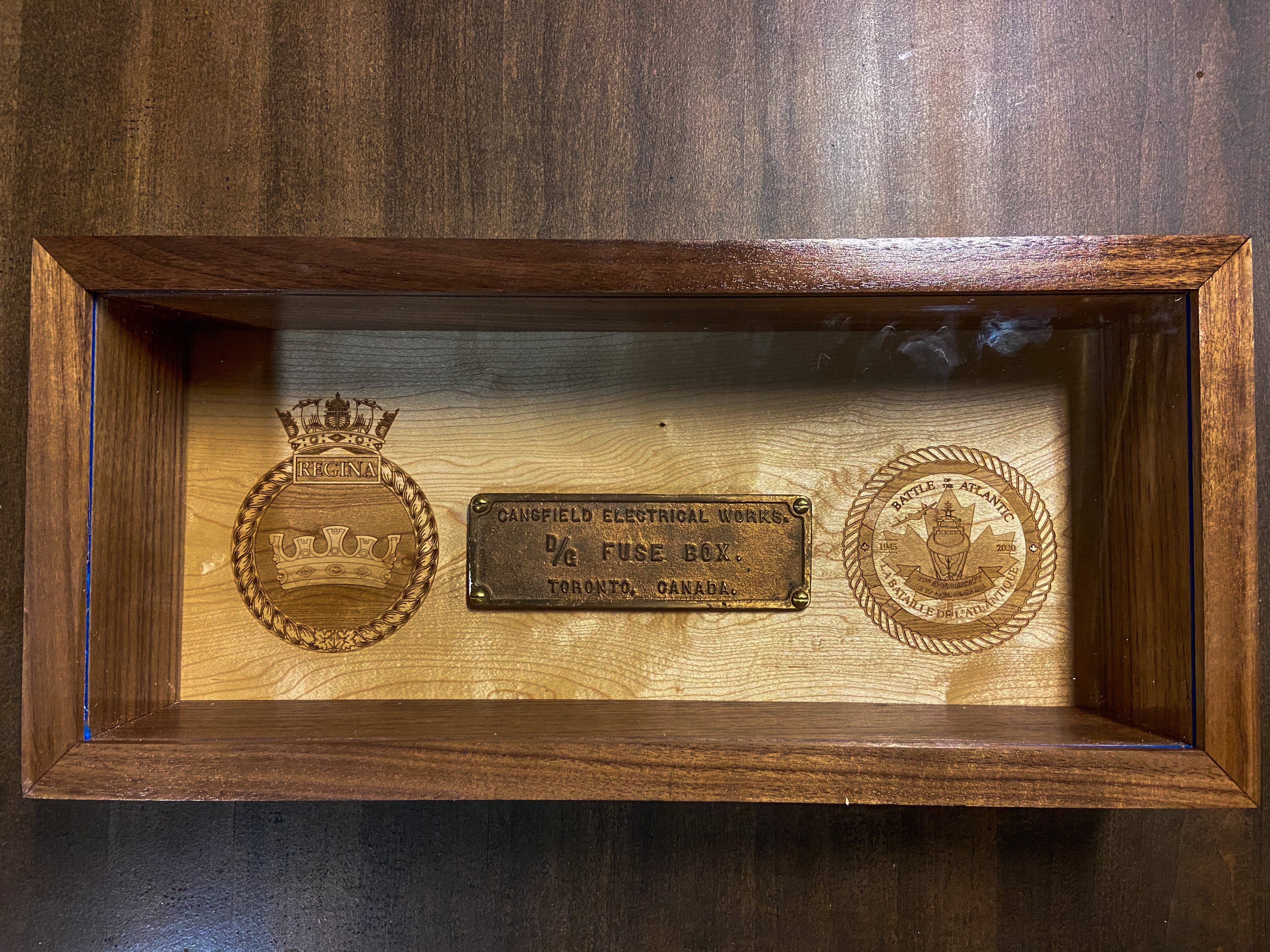Brass fuse box plate salvaged from wreck of wartime HMCS Regina
Navy News / November 18, 2020
A small piece of Canada’s naval history was recently salvaged from the wreck of His Majesty’s Canadian Ship (HMCS) Regina (K234), which was sunk by a German U-boat off the coast of England on August 8, 1944.
A brass fuse box plate was retrieved by a local diver and turned over to the United Kingdom’s Receiver of Wreck, who is responsible for salvaged artifacts. The Receiver of Wreck researches owners of wreck material, works with the finder and owner to return recovered material, and collaborates with other interested parties such as archeologists and museums.
In this case the brass fuse box plate, which measures approximately six inches, was turned over to the Royal Canadian Navy (RCN) through the Canadian High Commission in London.
Camilla Moore, Receiver of Wreck, presented the fuse box plate to Commander (Cdr) Jeff Dargavel, Commanding officer of HMCS Toronto, on October 29, 2020.
“It is my duty to attempt to return wreck material to its owner, and I am delighted that we were able to assist in returning the plate from HMCS Regina to the RCN,” said Ms. Moore. “It is particularly poignant given the circumstances of the vessel’s loss and the significance of the Battle of the Atlantic in its 75th anniversary year.”
The presentation was made on board Toronto during its recent visit to Naval Base Portsmouth, England, as part of the frigate’s mid-deployment rest and maintenance period. While alongside in England, mitigation strategies were adopted to minimize the crew’s risk of contracting COVID-19, including restricting shore leave. Toronto is presently deployed to Europe in support of Operation REASSURANCE, where it’s been operating with Standing NATO Maritime Group One.
“The crew and I were thrilled to accept, on behalf of the RCN, the brass tally plate from the wreck of HMCS Regina,” said Cdr Dargavel. “It’s not just a physical piece of our history, it’s also a conversation piece and I’m sure it will make sailors reflect on our history and remember the 30 lives lost after Regina was torpedoed and sunk in just 28 seconds.”
The artifact will be repatriated to Canada on board Toronto when it returns to its homeport of Halifax later this year. It will then be transferred to the modern day Her Majesty’s Canadian Ship Regina, the second RCN ship to carry the name.
To aid in the transport and storage of the artifact, several maritime technicians on board Toronto fabricated a shadow box made of wood featuring Regina’s crest and the RCN’s Battle of the Atlantic 75th anniversary crest.
“Since the artifact is from Regina and will be displayed in the current Regina, it seemed appropriate to engrave the ship’s crest into the shadow box,” said Cdr Dargavel. “Additionally, 2020 is the 75th anniversary of the Battle of the Atlantic and since Regina fought primarily in that battle, it also seemed fitting to engrave the RCN’s crest for the anniversary.”
In 1942, the Flower-class corvette HMCS Regina arrived at Halifax from the shipyards in Sorel, Que., on January 6 and was commissioned on January 22. Regina served with Western Local Escort Force until September, when it was reassigned to Operation TORCH, the invasion of North Africa. In November, after a refit, Regina was employed as escort to United Kingdom-Mediterranean convoys, and sank the Italian submarine Avorio in the western Mediterranean in February 1943.
After another refit in Canada, Regina joined Escort Group C-1 in the Mid-Ocean Escort Force in February 1944. At the beginning of March, it left Argentia, Nfld., for the United Kingdom, but fouled her screw while fuelling and was towed into Horta, Azores, by the rescue ship Dundee, escorted by the corvette HMCS Valleyfield. Arriving in Londonderry, Northern Ireland, toward the end of March, Regina was assigned to Western Approaches Command for invasion duties.
Regina was employed as an escort to English Channel and coastal convoys until she was torpedoed and sunk off Trevose Head, Cornwall, UK, by a German submarine. Thirty of her ship’s company were lost with the ship.
Late the night of August 8, 1944, Regina, the sole escort of convoy EBC-66, had slowed down to pick up survivors of the Ezra Weston, believing the American merchant Liberty ship had been mined. However, the cause of Ezra Weston’s misfortunes was no mine, but rather a torpedo fired from German submarine U-667. U-667 then fired another torpedo at the Regina, which sank in just 28 seconds.
Sixty-six surviving members of Regina’s crew were picked up by the armed trawler His Majesty’s Ship (HMS) Jacques Morgand and the landing ship HMS LCT-644, however, two crew members died of their injuries before reaching land.
Both the Regina and the Ezra Weston rest in 60 metres of water in the waters where they sank 76 years ago.
Page details
- Date modified:





